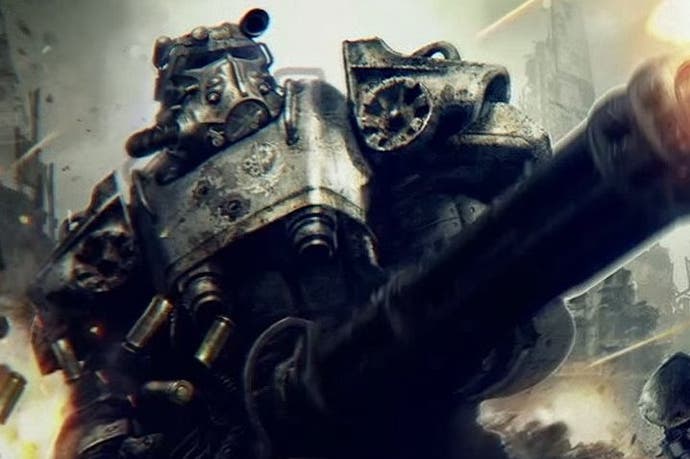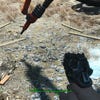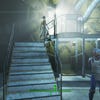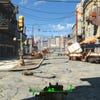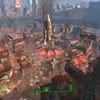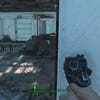Fallout 4: Next-gen or not?
What works and what doesn't as the Creation Engine transitions to a new hardware generation.
Much has been said of Fallout 4's graphics prior to its launch. Perhaps the most widely-leveled criticism is that it doesn't look like a 'next-gen' title in every aspect, but part of a line of games born from last-gen development. No doubt, Bethesda is in its element with the sheer scale of its world building - and certain leaps are made on a visual level. But questions were raised ahead of release; is this a true technical successor to Fallout 3? And has the Creation Engine evolved enough to a point where this could only be achieved on current-gen hardware?
Having picked the game apart over the last week across PS4, Xbox One and PC, it's fair to say repeat use of the Creation Engine from Skyrim draws a lot of parallels with that game. The sprawling dialogue tree system, the incredible volume to its world, the shifting time of day, use of physics-based items and ragdolls, and even the controller setup are eminently familiar. But new layers are added to the engine overall, giving a sense progress is being made - even if the skeleton of the studio's earlier work rattles underneath.
For a quick memory jog, we also went back to Fallout 3 on PC, maxing out all settings to see the standard Bethesda had to build on for Fallout 4. A generation on, and differences are stark for several reasons, both in art direction and technology. In particular, Fallout 4's biggest selling point is its new, physically-based lighting system - plus a suite of added effects that put it a cut above Bethesda's last effort. A 30fps target is set on PS4 and Xbox One too, keeping it on par with frame-rates in its last-gen titles.
Accepting its 30fps nature, we decided to go point-by-point through Fallout 4's biggest successes and failings as a current-gen title. Two years into this generation, the standard is already incredibly high on PS4 and Xbox One with open-world games, especially so with the likes of The Witcher 3 and Batman Arkham Knight on store shelves. So here's our take on what works in Bethesda's first stab at current-gen development - and what doesn't.
What works
- Physically-based materials: Easily the largest upheaval to the Creation Engine. We have a deferred lighting model in use, making the most of physically-based materials across the wasteland. Unlike Fallout 3's approximated approach, surfaces now react to light based on real-life properties. Whether it's the diffused lighting on clothing fabrics, or the sheen on the corrugated roofing across Diamond City, it marks Fallout 4's most eye-catching change. With more light sources possible per scene too, interior lighting benefits hugely, while outdoors, the PBR system ties in neatly with the series' rolling day-night cycle.
- Image quality: Somehow Bethesda manages to squeeze a native 1920x1080 framebuffer from both PS4 and Xbox One, with no dynamic resolution shenanigans. Once we emerge from the Vault 111 to a post-nuclear wasteland, image quality is an obvious plus point, especially jumping from the native 720p of last-gen Bethesda titles. A new temporal anti-aliasing method is also added, treating visual noise and flicker on panning motions - it's an interesting alternative to the multi-sampling anti-aliasing (MSAA) utilised on the PC and Xbox 360 games, and actually does an impressive job on the troublesome sub-pixel elements including trees and foliage.
- Draw distance: Even on consoles with their pared back object fade settings, Fallout 4's world is a treat to behold at a distance (just don't look too close - as we'll cover further down this page). There's a richness to the environments in Bethesda titles, and the Creation Engine's pairing with SpeedTree allows assets to stream in smoothly as we venture towards a new quest marker. Even on console, the fade-in logic is more gradual and subtle than Fallout 3, and only shadows visibly fade in ahead of the player.
- HDR and tone-mapping: We're going from the more gritty, apocalyptic setting in Fallout 3 to a much brighter, more vibrant backdrop in Fallout 4. The effectiveness of the change in art style comes down to a personal preference, but Bethesda's post effects support this more vibrant world design well. Pastel shades are used across houses, with the image treated by a filmic tone-mapping pass, adjusting the colour balance of the image dynamically, whether it's daytime or night. This includes a use of high-dynamic range, to simulate a camera exposure's to the light sources too.
- Volumetric lighting: Fallout 4 utilises Nvidia technology to produce volumetric lighting, allowing light to scatter more convincingly across the air. This is impacted by newly added smoke and fog effects in the distance, and also produces the long light shafts we see trailing around objects occluding the sun. Compared to Fallout 3, it's an impressive effect that adds a great sense of depth to each environment - one highlight being the film noire-like smoke that collects under spotlights at Diamond City's press office.
- Weather effects: Added to that, physically-based lighting makes the most of Fallout 4's weather states, such as rain. Material properties change during rainfall, and we get a dewy, wet sheen across on surfaces once it kicks in across big city areas. A torrential downpour can quickly transforms the look of the world, unlike surfaces in Fallout 3 which remained fixed.
- Animations: It's been a pet peeve of ours for a while, but the third-person camera mode in Fallout 3 and Skyrim has always felt like a tacked-on extra. Character movement isn't tuned properly, causing the character to slide, frictionless, across the floor as you strafe left or right. Fortunately, Fallout 4 fixes this, and the body rig reacts to the dimensions of the environment properly, with each step landing where it should at each turn. It's been a long time coming.
On top of this, motion capture is deployed during certain cut-scenes; specifically ones following the main stem of its narrative. It heightens the drama where applied, though as you'll see below, not all performances escape the uncanny valley. At its best moments, we're looking at a more polished product than Fallout 3, though it's not a scratch on the industry-leading capture tech used in the likes of Uncharted.
What doesn't
- Geometry: It's fair to say something feels lacking in Fallout 4 when looking close at the world. Though impressive at a range, geometry for scenery is often simplistic in close quarters, with notably angular points to characters and walls. Built for scale, it gets a pass here to an extent, though some areas look more primitive than we'd expect of such a big budget title on PS4 and Xbox One. All told, Fallout 4 doesn't always hold up to close scrutiny - a sign its world design may have originally been budgeted for less endowed platforms.
- Frame-rate: This one's a particular disappointment. As covered in our performance analysis, PS4 and Xbox One trip up in the pursuit of a solid 30fps. As of patch 1.01, we see nosedives to 20fps in-between cities, plus prolonged drops at the centre of NPC-packed areas, or effects-heavy battles. Simply put, the game doesn't feel perfectly fine-tuned for modern consoles, and if a smooth frame-rate is top of your priority list, PC is a much safer bet - but even this has its issues.
- Animation: Characters are more detailed on the whole, with improved skin shaders mapped across the leading cast. However, in motion they are let down by some less-than-flattering animations. The quality varies from scene to scene, but one early dialogue sequence with a salesman shows some truly awkward lip sync at work. The results are uncanny, though we're glad to see more attention paid to major characters later on.
- Volumetric lighting: We're hugely fond of this effect in Fallout 4, though on PS4 and Xbox One it is noticeably dialed down in quality compared to PC's top setting. In this case, something in the region of a 480x270 resolution is in play where geometry edges intersect with light shafts. It's a fraction of the full 1080p image, and creates a strange, dithered artifact at points, running at odds with the crispness of every other on-screen element. This isn't a complete deal-breaker though, and it takes the right angle to catch it.
- Motion blur: Boasted as a new feature in its technology breakdown, motion blur is rarely in evidence in Fallout 4. Neither per object or screen blur are in play when panning the camera or performing a melee attack, though the setting is clearly available as a checkbox on PC's settings menu. The closest we've seen to its use is a shader effect that kicks in when grenades and mines trigger off nearby. It's fair to say the use of motion blur is sparing at best, and we had hoped to see more from the effect.
- Ambient occlusion: Consoles use an older, less precise, screen-space ambient occlusion (SSAO) in Fallout 4. This also represents PC's best and only official ambient occlusion setting in its menus, and fills each corner with pockets of shade. Compared to a game like Skyrim, we'd rather have the effect than go without - but this approach shows its age, and shadows produce a distracting flicker around characters. Newer and subtler versions of the effect, such as the horizon-based version HBAO help avoid this while still retaining depth. But in this case, this is the best we've got.
- Depth of field: A bokeh depth of field filter is also reportedly added, kicking in with cinematic shots during dialogue, plus on scoped weapons. It's a less refined approach however, and we've seen sharper, clearer, more precise uses of the effect in other games. In particular, we're missing the distortion to light points that typifies a bokeh form of the effect. In its current state, it simply blurs the background, much like a gaussian form of the effect.
All told, Fallout 4 does feel like a step forward in technological terms, if not the giant leap we had hoped for. The physically-based lighting, its interplay with weather conditions, and a suite of new effects make it stand apart from Fallout 3 on the surface. Aspects of its presentation fall behind the curve though, and the world overall appears a touch flat, plus we still see lengthy loading screens when fast-travelling between major areas. On PS4 and Xbox One, we also stick to the 30fps target of its last-gen games too, with variable delivery in hitting that number as we've discussed in our performance analysis.
It's disappointing on these points, and we suspect Bethesda's tools could have used a more thorough refresh for its first PS4 and Xbox One project. The team recently revealed the game's development began with porting Skyrim to Microsoft's new machine, and Fallout 4's inheritance is often clear to see in playing the game. But there's a legacy to Bethesda's underlying tech that it clearly feels at home with - a method that has helped realise a huge apocalyptic playground few other developers are able to match for scope.
The end product in Fallout 4 is an unusual mixture of old and new. It undoubtedly follows a familiar template underneath, but the new lighting model layered over the top gives it an often-times beautiful, current-gen veneer. Certain new effects already look dated, but regardless, it has a flexibility most games don't offer, with its wide scope for exploration, and a freedom granted by its dialogue options. It's not a knockout blow in technical terms, but it still impresses in its own way - and hopefully this marks the first step of many, as Bethesda continues to develop for PS4 and Xbox One.
If you've come unstuck in the game, our Fallout 4 guide is live now.
